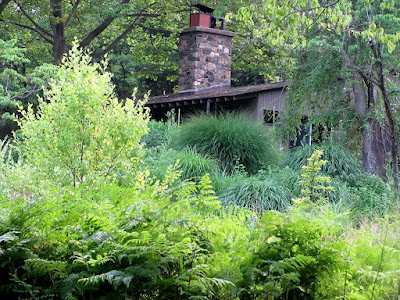Never having attended to planting at the top of the stone wall, I needed to kill bindweed and poison ivy that had become entwined with the existing plants. No getting around general destruction. Roundup (used very judiciously, in targeted areas, shown below) killed all growth at the edge, though I did manage to save one large Sanguisorba tenuifolia. Now to wait and see if it killed the roots of these two pestilential plants.
Selective cutting of the meadow grasses has begun (below). I do this after the wildflowers have gone to seed, and to reduce competition with preferred grasses and perennials--panicums, Filipendula ulmaria, Japanese and Siberian irises, Silphium perfoliatum. When time permits and materials are available, I want to add a small, one-person path wandering through this area, giving access to the pond side off to the left, and keeping the feet above the ever present wet from fall through early summer. Here is another example of extensive maintenance: the cuttings are left on the ground, to decompose in place, and over time, to increase the organic content of my mostly mineral clay. No time for nasty neat.
View across the garden. A 30-foot-long planting of Filipendula rubra 'Venusta' is in bloom on the right; the pink color looks rather faded in the bright afternoon light, but I grow this plant mostly for the sharply angular, almost chartreuse foliage, and for its vigor in my difficult soil. Sanguisorbas, Joe Pye Weed, Iris virginica in the foreground, further back Rudbeckia maxima, Lysimachia ciliata 'Firecracker', more irises. Most of this will be burned in late winter--another labor saving practice, and it's good for the grasses.
Looking across the pond, obscured by plant growth, toward the miscanthus bank, with the strip of intentional devastation caused by glyphosate. In the foreground is Panicum 'Heavy Metal' and 'Cloud Nine', more Silphium perfoliatum, Ligularia Japonica about to bloom at the front. The miscanthus makes a very good, though quite large, ground cover, helping keep undesirable plants under control.
More views of the filipendula, since it's the floral "star" of the moment. I'll like it much better when the pink fades to more subtle copper tones.
We've had increasing heat, without much rain, which is sending these Silphium laciniatum rocketing skyward (these are about eight feet tall now). They must have put on three feet of growth in the past week. These plants always flop when they get too tall. I'm hoping the lack of water will make them strong enough to stand on their own this year. We'll see; thunderstorms are predicted for today.
The silphium with more Rudbeckia maxima and Vernonia fasiculata. The ground surface shows where I've cut a path for walking through the plants (wide enough for one lone person). Yet another project is to add a gravel surface to make the path permanent.
Close-up of the silphium ...
No time for raking gravel back into place after storms or other disasters, thus the borders of rock (native, of course) to keep all in place. Eventually there may be ground covering plants bordering the path, but only as time permits, and only if nature cooperates. I don't mind the grasses.
Another vigorous plant that helps with spotty maintenance. Eupatorium cannibinum, a European eupatorium, seeds itself around, eventually making large masses if left to itself, but easily pulled out if not wanted. It obscures a multitude of sins. Here it's just coming into bloom.
Another useful plant, for the water's edge, that makes a lovely mass of color, shape and texture--Pontadera cordata. It's vigorous enough to outcompete the weeds.
Much of my approach to extensive maintenance, in case you haven't noticed, is to use large, rather highly competitive plants, which just happen to be well suited to my conditions. Here the plants appear to be eating the house.
Miscanthus, willows, river birch - they cover a lot of ground.

































































